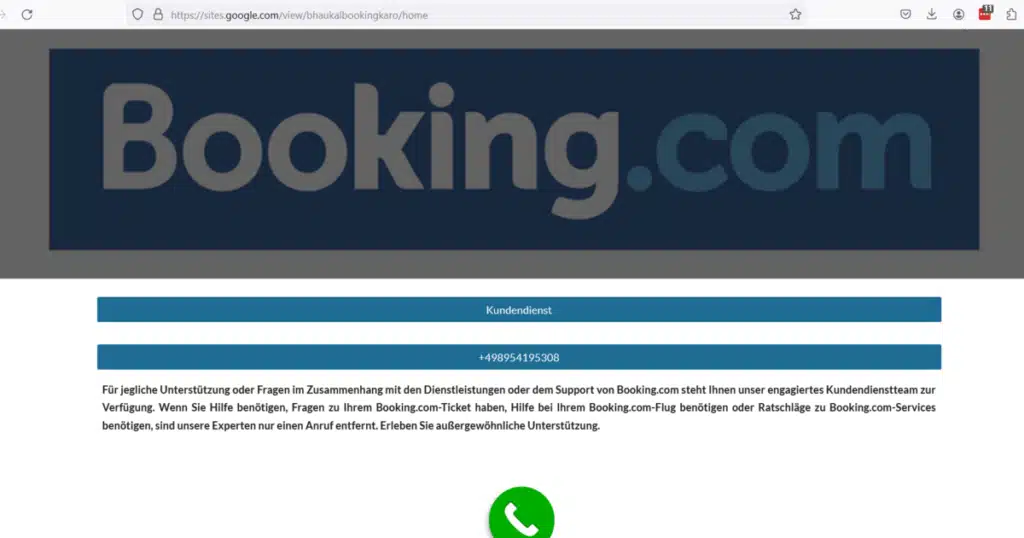The digital world offers many advantages, but is also a playground for fraudsters. An increasingly common scam is the fake contact pages of well-known companies such as Booking.com. Criminals create deceptively genuine websites, complete with logos and designs of major brands, luring users into a trap that can result in serious financial losses. A particular target of these fraud attempts is currently Booking.com's customer service. Fake phone numbers on these sites lead unsuspecting users to scammers posing as customer service representatives.

The scam: Fake customer service hotlines such as those from Booking.com
The scam strategy is sophisticated and often starts with a simple Google search for contact information. Users looking for a service hotline for companies like Booking.com or Ryanair may come across a fake website. A call to the phone numbers provided will not connect you with real customer service, but rather directly with the scammers. These pose as helpful employees whose only goal is to gain the trust of callers.
After trust has been established, the next step of the fraud follows: the callers are persuaded to install remote maintenance software such as AnyDesk or Zoho. This software gives the fraudsters full access to the victim’s device. They can then install malware, spy on sensitive data and even carry out transactions unnoticed.
How do you recognize fraud?
There are some warning signs that you may be dealing with a scammer. The first sign is the website URL. Official company pages usually have a simple and direct URL. On scam sites you will often find complicated addresses or subdomains that have nothing to do with the actual company. (See the screenshot above.) If the conversation asks you to install software or approve payments, this is a clear sign of fraud.
What to do if you are affected?
If you have already fallen into the trap, there are some important steps you should take: Contact your bank immediately to stop any payments. Remove the installed remote maintenance software and check your device for malware. It is also advisable to report it to the police. Don't forget to contact the real customer service of the affected company to resolve your actual concern safely.
Questions and answers about fake customer service hotline scams:
Question 1: How does the fraud with fake customer hotlines work?
Answer 1: Scammers create fake websites similar to those of well-known companies and provide false contact information. Callers are tricked into installing remote maintenance software that gives the fraudsters full access to the device.
Question 2: How do I know if it is a scam site?
Answer 2: Pay attention to the URL of the page and be suspicious if it asks you to install software or make payments during the conversation.
Question 3: What should I do if I have already fallen victim to such a scam?
Answer 3: Contact your bank immediately, remove the remote maintenance software, check your device for malware and report it to the police.
Question 4: How can I protect myself?
Answer 4: Use only the companies' official websites and phone numbers and be skeptical if you are asked unusual questions during a customer service conversation.
Question 5: Why do fraudsters use the customer service of well-known companies for their scams?
Answer 5: Because users trust customer service and are more willing to follow instructions, making it easier for fraudsters to access personal and financial information.
Conclusion
The increase in scams caused by fake customer service hotlines is alarming. Fraudsters cleverly exploit people's trust in big brands like Booking.com to achieve their criminal goals. It is important to be vigilant and verify the authenticity of contact pages and numbers before revealing personal information. If you have any suspicions, you should act immediately and follow the steps above.
Don't forget to subscribe to the Mimikama newsletter at https://www.mimikama.org/mimikama-newsletter/ and find out about our online lectures and workshops at https://www.mimikama.education/online-vortrag-von -mimikama/ to inform.
Source: watchlist-internet
Also read:
Notes:
1) This content reflects the current state of affairs at the time of publication. The reproduction of individual images, screenshots, embeds or video sequences serves to discuss the topic. 2) Individual contributions were created through the use of machine assistance and were carefully checked by the Mimikama editorial team before publication. ( Reason )

